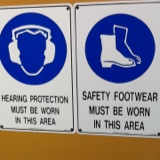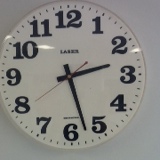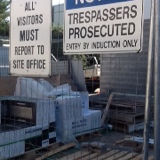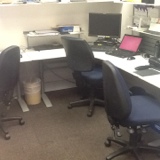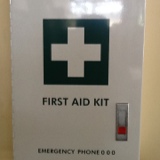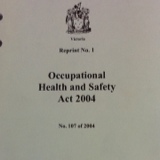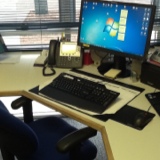Information
-
Document No.
-
Audit Title
-
Client / Site
-
Conducted on
-
Prepared by
-
Location
-
Personnel
-
Contractor
-
Company
-
Facilities Job Captain/Project Manager
-
Principal Contractor
-
Does the contractor know who their Job Captain for this work is
-
Work request for works sighted
-
All staff on sight are inducted - CIM system or closed site
-
Is the work site a Medium / High Risk site?
-
All staff on construction site have their "Construction Induction Card"
Site Safety Management Plans
-
Site specific Safety Plan on site and accessible for all site staff to view
-
Inductions completed and recorded on register
-
Accident and emergency plan completed
-
Toolbox meetings recorded
-
Project hazard assessment (risk register) completed
-
Consultation methods being recorded and itemised
-
Safe Work Method Statements are in place for medium and high risk tasks
-
Hazardous substances register is maintained
-
Evidence that Safety inspections are taking place
-
Safety Signs are posted around site e.g. Hard hat, safety boots, eye & hearing protection, Hazchem signs
-
Fire Precautions provided on site, e.g. Hose reel etc.
-
Overhead electrical conductors protected
-
There is safe access and egress from site
-
Site suitability protected against public access e.g. barricades, fencing, hoarding, lighting etc.
-
Building materials safely stacked and secured e.g. Pipes, ply, roof sheeting etc.
-
Lighting is adequate to perform work safely
-
Evacuation Procedure - A site plan showing nominated assembly area/s and emergency contact details is located in prominent areas around the site
Slips / Trips / Falls
-
Is the workplace clear of slip/trip/fall hazards
-
Is equipment / materials stored in walkways or aisles
-
Are steps or stairs adequate for purpose (not slippery etc)
-
Are workers exposed to risks in walkways and aisles near mobile plant, machinery etc:
Amenities
-
Sound/weatherproof construction shed
-
Adequate ventilation, heating, cooling & lighting
-
Protected against insects & vermin
-
Adequate clean, fresh drinking water
-
Clear access and egress from all amenities
-
No building materials or equipment stored in amenities
-
Power supplied to all amenities is construction wiring & identified as such
-
Change & meal rooms must be separate or separated by an internal wall
-
Have toilets been installed and maintained to prevent odours from reaching food areas
-
Washing facilities within or adjacent to toilet with clean water (hot where practicable) & soap, mirrors, hand drying & garbage bins
-
Change rooms where work requires clothes to be changed with bench seating & clothes hooks. Change rooms should have some form of heating
-
Showers are provided when dirty work requires it; note - number of showers depends on the number of site staff requiring showers. Showers should have hot & cold water, curtain or door, soap & soap holder, non slip flooring, clothing hook
-
Meal room (1m*) for each person with:
-
Adequate tables and seating
-
Ventilation/cooling/heating
-
Refrigerator, food warmer, sink with clean water supply
-
Boiling water
-
Garbage bags with liners
-
Shelves for storage
First Aid
-
First aid kits appropriate for size & type of site
-
Sufficient number of trained first aiders appropriate for current number of employees on site
-
A portable first aid kit is available to be taken out on site if required
-
First aid kit/s are easily accessible to all working on the site
-
Notice near the first aid kit/room displaying names & telephone numbers of first aiders
-
Injury register is maintained with a record of all injuries
-
Kit has been checked bi-annually and evidence of the check is recorded
Electrical
Switchboard ........
-
Waterproof
-
Loackable
-
Located on site
-
Securely fixed to structure
-
Identifies the power feed source
-
Have the RCD'S been enclosed
-
Does the MSB have an isolating switch
-
Are there no sharp edges that could damage cords
-
Show evidence of safe system of work; lock off tags and padlocks etc
-
Construction wiring is distinguished from permanent by cable colour (usually yellow) or yellow tape at intervals less than 5 meters
-
No double adapters or piggy back plugs are being used
-
Ensure extension cords are not joined together
-
Do they have up-to-date inspection tags (monthly inspection by a qualified person) and are the inspection details recorded in a log book by the owner
Power, machines, portable tools and appliances
-
Guards, blades, outer casings,power cords, on/off switch, all in good condition
-
Inspection tags are up to date and the details recorded in a log book/register
-
Electrical appliances in amenities sheds/site offices are inspected & tagged upon arrival & then at 3 monthly intervals.
Falling Objects
-
Do all workers have hard hats where required
-
Are all barricades & kick boards erected so that tools and building materials won't fall on people below
-
Overhead protection is provided when work is being carried out on the perimeter of a building to protect persons below (where practicable otherwise barricading & signage)
-
If there is a risk of objects falling on people (workers, general public) then the area where the object could fall is barricaded
-
Do people working at height secure their tools with lanyards
Emergency Control
-
Site plan is located in site office (and around the site on larger projects
-
Site entry/exit is safe and well signed
-
First aid facility
-
Evacuation path/details
-
Evacuation assembly area/s signed
-
Emergency contact numbers are clearly displayed
-
Chief warden details are displayed
Working at Heights/Fall Prevention
-
Have all tasks been identified, assessed and controlled where there is a risk of a fall greater than 2.0 meters? (SWMS required)
-
Persons over 2 meters from the ground (who are not connected to an approved arrest system) are working from an approved working platform (scaffold, gantry)
-
Are floor penetrations securely covered?
Roof Work
-
Guard rails are installed and/or fall arrest system (harness, lanyard, static line) is used
-
Has the roof work been assessed and planned in accordance with the prevention of falls in General Construction Compliance Code.
-
People working at height (greater than 1.8 m) outside guard rails; Are the connected to an anchorage point that will withstand the force of the falling person (according to AS1891.3, AS2317 and manufacturer's instructions).
-
There is safe access to and from anchorage points
Scaffolding/working platforms
-
Scaffolds above 4 meters are erected/altered/dismantled by a scaffolder holding the appropriate scaffolding qualification
-
Is the scaffold constructed on sufficient foundation
-
Is the adequate bracing in all directions
-
Are all working platforms fully planked
-
Scaffolding above 4 meters that remains erected is inspected once a month by a licensed scaffolder. Inspection details recorded on site site scaffold register or on a scafftag.
-
Are there handrails and kick boards for all working platforms more than 2 meters high?
-
Is scaffolding tied to the building at least every 3.6 meters in height & length?
-
Scaffolds not within 4.6 meters of live electrical conductors?
-
Wheels on mobile scaffolds lockable & locked when in use?
-
Are outriggers used on mobile scaffolds when the height is greater than three times the width of the base?
Ladders
Ladders
-
On firm and level ground when in use
-
Intact & in good condition
-
Away from doors and access ways
-
4.6 meters from live electrical conductors
-
Made of non-conducting material when being used near electrical equpment
-
Ladders are rated Industrial type only
Extension Ladders
-
Stable and securely fixed at the top and bottom
-
Angle at least on in four extend at least on meter above the top platform
-
Locking mechanism works
-
Only used as access/egress (no work to be done)
Step Ladders
-
Non slip footing
-
Spreader bars locked in position - worker has 3 points of contact at all times
-
Worker is at 3 rungs down from the top of the step ladder
Excavations & Penetration
-
Have underground services in excavation vicinity been identified and isolated prior to excavation commencing?
-
All excavations are barricaded and made visual to pedestrians and vehicles at all times e.g. Handrail, barricading, reflective tape or lights.
-
Excavations deeper than 1.5 m require SWMS to be completed for the work. Has WorkSafe been notified? Where there is a potential fall of 2m or more physical barriers must be erected.
-
Safe means of access and egress from the excavation are provided at all times.
-
Persons operating excavation equipment has the appropriate license or certificate to operate the machinery.
Respiratory Hazards
-
Adequate respiratory protection (e.g. Dust masks) is worn in dusty environments, particularly when dealing with:
-
If possible, dusty work processes and areas are isolated.
-
If possible, dusty work processes and areas are wet down
-
Good house keeping procedures (e.g. Vacuuming with HEPA filter or wet sweeping and wet c,earning are carried out)
-
Asbestos, if present on site, in any form has been identified, and the locations communicated to the workers on site? Arrangements have been made for its removal by an approved sub contractor.
PPE
-
All personnel wear PPE when either specified on site signage, through a directive from the site foreman, or when the SWMS requires it.
-
Safety footwear complies with AS 2210 e.g steel cap with adequate tread to prevent slipping.
-
Safety helmets (AS 1801) are available on site for visitors and employees.
-
Safety glasses/faceshields (AS 1337) are work when there is danger of splashes from chemicals or corrosive, or grit in the eye from dust of flying objects or welding flash.
-
High visibility vests are worn on and around site when there is a pedestrian/traffic/mobile plant or security hazards.
-
Sunscreen is available for employees working outdoors.
Plant & Equpment
-
Only authorised/licensed personnel operate plant equipment.
-
Operators conduct pre-shift check of all plant/equipment.
-
Plant register for registered plant site.
-
Equipment checks are maintained
Traffic Management
-
Is there a up to date Traffic Management Plan for the job
-
Are all workers involved in the Plan, trained in Traffic Management?
-
Are the Traffic Management control measures adequate for the task?
Fire Prevention
-
Flammable goods are stored appropriately.
-
No smoking rules enforced
Fire Extinguishers
-
Kept in fire hazard locations
-
Positioned at exits as per BCA
-
Regularly inspected & tagged
-
Labelled and clearly sign posted
-
Combustible materials are kept well away from ignition sources
Hot Work
-
Fire extinguisher is in immediate proximity of work
-
Protection screens used
-
SWMS is prepared & signed off for hot works
-
Is there a hot works permit system, and is it being followed
-
PPE including face shield goggles & gloves are worn
-
Oxy/Acetylene bottles are secured.
Noise Management
-
Noisy areas & tasks have been identified & signs have been erected
-
Can the job Substitute noisy machine for quieter one
-
Isolate noise source behind sound absorbent wall or curtains
-
Move noisy machinery as far as possible away from workers
-
Are the people using noisy machinery and others working near it wearing AS1270 approved protection?
Manual Handling
-
Objects are lifted and tasks are conducted without excessive physical strain.
-
Mechanical aids are used when a manual handling risk is identified.
Hazardous Substances & Dangerous Goods
-
Material Safety Data Sheets (MSDS) for all hazardous substances are kept on site and are accessible to all site personnel (in the first aid room)
-
Hazardous substances are used, handled and stored according to the methods prescribed in the MSDS
-
Adequate training, instruction and information is provided for workers to use hazardous substances safely
-
All containers of substances are labelled clearly and correctly
-
The type and amount of hazardous substance stored or used on site is recorded in the hazardous materials register
-
Does the total quantity of flammable and combustible liquids stored on site comply with the maximum amounts prescribed for minor storage in table 2.1 of AS1940? If not DG license may need to be arranged and/or storage methods improved.
-
Gas cylinders (indoors), not more than the following empty or full containers:
-
7 of Acetylene
-
5 of LPG Forklift
-
3 of 45 kg LPG
-
10 of non-flammable gas (green diamond label)
-
Dangerous goods of different classes (refer Hazchem label) are not stored in the same area and can't mix if spilt (spilled?)
Waste Management
-
All loads of rubbish removed from site are securely covered to ensure no spillage
-
No site waste is in Deakin University bins
Dust & Air Emissions
-
Stockpiles are damp or covered when required (ie during high winds)
-
Areas of high dust are being kept wet (eg demolition)
-
Powered machinery has appropriate particulate control, and doesn't emit large amounts of smoke
Erosion & Storm Water Management
-
Stockpiles have silt fence on downstream side.
-
Sediment Control Devices e.g straw bales filters, gravel surface barriers, sandbags, pit baskets or geo-textile fabrics are installed at runoff points, as per SEMP to prevent sediment entering the storm water system
-
Groundwater is not to be discharged to storm water OR sewer without water authority approval
-
Contractor Signiture
-
Auditor/s Signiture
-
Comments / Actions
